
In the ever-evolving world of digital marketing, one trend is reshaping how brands communicate with customers—conversational marketing. With chatbots and live chat tools leading the charge, businesses are now building deeper, real-time connections with users that drive both satisfaction and sales.
Today’s customers expect immediate answers, personalized interactions, and human-like conversations—even when no human is available. This is where AI-powered chatbots and live chat systems shine. Let’s dive deep into how these tools are revolutionizing customer experiences and why conversational marketing is the future of engagement.
Conversational marketing is more than just a buzzword—it’s a shift in how businesses talk with customers rather than at them. Traditional marketing was one-directional: brands broadcast messages. Conversational marketing, on the other hand, emphasizes real-time dialogue.
It’s powered by instant communication tools—chatbots, live chat widgets, and AI assistants—that allow businesses to respond instantly, guide users through decisions, and build trust seamlessly.
This evolution mirrors a broader cultural trend: customers crave connection, not just conversion.
Chatbots have come a long way from clunky, scripted responses. Modern bots are powered by natural language processing (NLP) and machine learning, allowing them to interpret questions, personalize recommendations, and even simulate empathy.
Why Chatbots Matter:
24/7 availability: They respond instantly, even after business hours.
Scalability: Handle thousands of chats simultaneously.
Personalization: Suggest products or solutions based on user behavior.
Efficiency: Free up human agents for more complex queries.
From booking appointments to generating leads, chatbots are now indispensable tools for e-commerce, SaaS, and service-based businesses alike.
While chatbots handle automation, live chat adds the essential human element to digital communication. Customers still value speaking to a real person when it matters most—especially for emotional, complex, or high-value interactions.
Benefits of Live Chat:
Builds trust faster than email or forms.
Shortens sales cycles by resolving objections instantly.
Increases customer satisfaction through empathy and understanding.
Captures valuable real-time feedback to improve services.
The magic lies in hybrid chat systems—where bots handle initial queries and seamlessly hand over conversations to live agents when human input is required.
The smartest companies aren’t choosing between chatbots and live chat—they’re integrating both. This hybrid approach creates a seamless customer journey: bots qualify leads, provide quick answers, and escalate conversations to live agents when necessary.
Here’s how it works in practice:
Chatbot greets the user and asks a few smart questions.
AI filters inquiries—routine ones are handled automatically.
Live agent joins for high-value leads or complex concerns.
Data syncs with CRM systems to personalize future outreach.
This combination increases efficiency while maintaining authenticity—a perfect balance between automation and personalization.
In 2025, consumers expect speed, personalization, and convenience. Conversational marketing delivers all three. Studies show that over 70% of customers prefer messaging businesses over email or phone calls.
The core reasons for this boom include:
The rise of mobile-first interactions
Growing adoption of AI and chat automation
Consumers’ preference for instant responses
Improved conversion rates through interactive communication
By meeting customers where they already are—on messaging apps, social media, and websites—brands are turning conversations into conversions.
Conversational marketing isn’t just about talking—it’s about selling through dialogue. Every message, response, or emoji can move customers closer to a decision.
Here’s how it boosts conversion rates:
Personalization: Real-time chats tailor offers to each user.
Reduced friction: Fewer steps between interest and purchase.
Instant support: Overcomes objections before cart abandonment.
Data-driven follow-ups: Bots remember previous interactions for smarter retargeting.
When done right, conversational marketing shortens the customer journey from days to minutes.
To get the most from conversational tools, focus on humanizing automation and streamlining workflows.
Pro Tips:
Give your chatbot a name and friendly personality.
Train it to recognize intent, not just keywords.
Offer quick replies and fallback options when unsure.
Make it easy to connect with a live agent anytime.
Use chat data to improve FAQs and content strategy.
The goal is not to replace people but to enhance human connection at scale.
Looking ahead, conversational marketing will continue evolving with:
Voice assistants integrating with chatbots for cross-platform support.
Hyper-personalized AI chats based on user emotion and tone detection.
Augmented reality (AR) chat for immersive experiences.
AI-powered analytics to predict customer needs before they’re voiced.
As technology grows smarter, conversations will become even more natural, contextual, and valuable.
Chatbots and live chat aren’t just tools—they’re transforming how brands build relationships. Conversational marketing bridges the gap between automation and authenticity, allowing businesses to engage, nurture, and convert customers with ease.
The future belongs to brands that listen, respond, and connect—one message at a time.
What is conversational marketing?
It’s a real-time approach to marketing where businesses engage directly with customers via chat, messaging apps, or voice tools to drive conversions.
Are chatbots replacing humans?
No. Chatbots handle repetitive tasks while humans manage complex, emotional, or high-value interactions.
How can chatbots improve conversions?
They qualify leads instantly, offer recommendations, and keep visitors engaged—reducing bounce rates and abandoned carts.
What platforms support conversational marketing?
Tools like Intercom, HubSpot Chat, Drift, and ManyChat are popular options for websites and social media.
What’s the main difference between chatbots and live chat?
Chatbots automate communication using AI, while live chat connects users directly with human agents.
Will conversational marketing continue to grow?
Absolutely. With AI advancements and rising customer expectations, conversational marketing is becoming a cornerstone of digital engagement strategies.
Phone: +1 844-945-2863
What’s App: 639254595080
Need help or have a question?
Contact us at: clientacquisition@envoyvirtualsolution.com